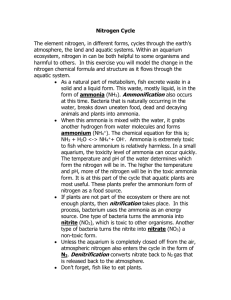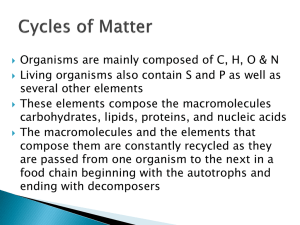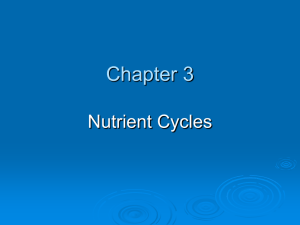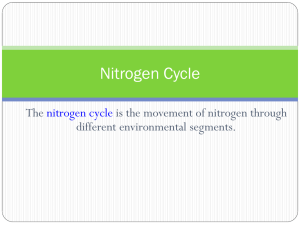Nitrogen Cycle in Aquaponics
advertisement
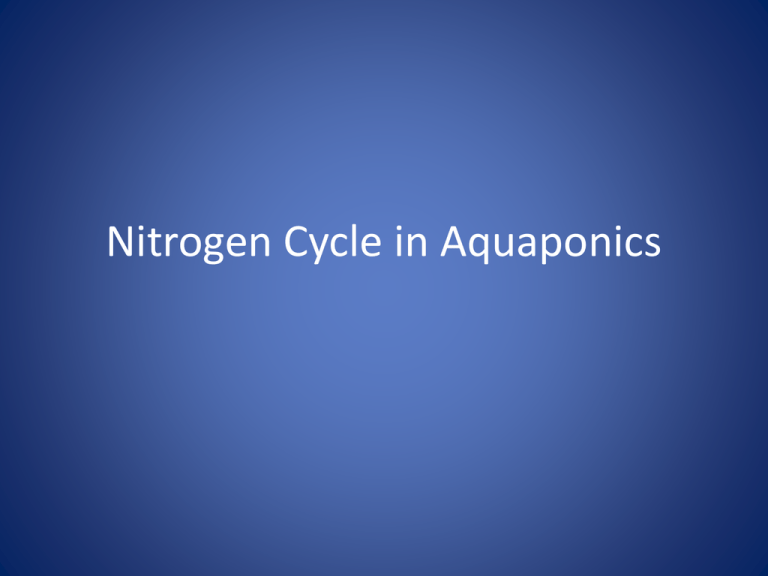
Nitrogen Cycle in Aquaponics Nitrogen cycle • Nitrogen is a fundamental element that is necessary for all forms of life on Earth. Nitrogen is an important component in both plant and animal cells. • Organisms need nitrogen to produce proteins, nucleic acids, and amino acids. Although Nitrogen gas (N2) is roughly 78% of the earth’s atmosphere, it is unusable in this form. • The majority of organisms on earth can only use nitrogen when it is ‘fixed’ – combined with carbon, hydrogen or oxygen. • The nitrogen cycle is the process by which microorganisms convert the nitrogen in the air and organic compounds (such as within soil) into a usable form. Composition of Atmosphere • Nitrogen is the major gas in the atmosphere. • Why would nitrogen be limiting if it makes up most of the atmosphere? Nitrogen Cycle • Unlike carbon or oxygen, nitrogen is not very available to life. • It’s conversion to a useable form requires biological activity • Cyclic conversions from one form to another are mainly mediated by bacteria. Nitrogen cycle and Aquaponics • The Nitrogen cycle is the most significant process within aquaponics. It is responsible for the conversion of fish waste into nutrients for the plants. • Without this process, the water quality would deteriorate rapidly and become toxic to both the fish and plants in the system. • The water therefore in aquaponics does not need to be treated chemically to make it ‘safe’ nor does it have to be replaced. • In aquaponics, a system is said to have ‘cycled’ when there are sufficient quantities of bacteria to convert all the ammonia into an accessible form of nitrogen for the plants. • The bacteria will arrive naturally to a system and colonize the water column and biofilter (usually clay pebbles, gravel or netting). Why do plants need Nitrogen? • Nitrogen is one of the main elements in protein. Nitrogen is also a component of nucleic acid, DNA, RNA, genes, chromosomes, enzymes, chlorophyll, secondary metabolites (alkaloids), and amino acids. • Protein is essential for all living organisms, and is required for growth and development. • Nitrogen accounts for about 1 to 6 % of plant dry matter, depending on the species and is often the limiting factor in plant growth. Bacteria in Aquaponics • One of the most important yet least understood aspects of Aquaponics is the bacteria that we rely on and its function in the nitrogen cycle. • I know what you’re thinking, bacteria (or “GERMS” if you watch a lot of disinfectant commercials) are meant to be bad, aren’t they? • The fact is that there is good and bad in everything, even down to bacteria. Life wouldn’t be possible without them. Ammonia Toxicity Fish excrete ammonia (NH4). In a lake or ocean it’s all good because the vast volume of water dilutes this ammonia. When you’re keeping fish at home or in an aquaponics lab it needs to be managed as it is very toxic to the fish. Decomposing food also creates ammonia. Some of the effects of excessive ammonia include: • Extensive damage to tissues, especially the gills and kidney • Impaired growth • Decreased resistance to disease • Death • Keep below 1ppm Ammonia Nitrite Nitrate • Luckily natures got it all sorted! The Nitrosomonas sp. Is a good little bacterium that eats ammonia and converts it to nitrite (NO2-). • Now, nitrite is much less poisonous to the fish than ammonia, but it’s by no means a good thing. It stops the fish from taking up oxygen (keep below 5ppm). • Natures got it under control again, with Nitrobacter sp. This good bacterium eats nitrite and converts it to nitrate (NO3-). Luckily nitrate happens to be the favorite food of plants. Also the fish will tolerate a much higher level of nitrate than they will ammonia or nitrite.
